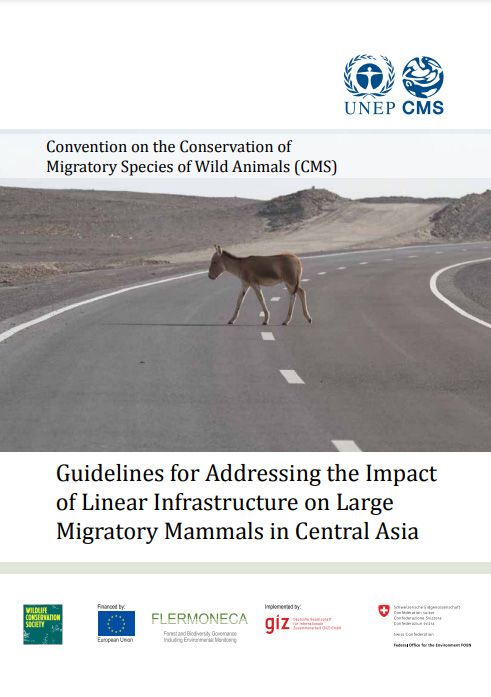First Community-based Area for Saiga Conservation in Kazakhstan

Saiga Antelopes © Evgeniy Polonskiy
Authors: Stefan Michel, Nature and Biodiversity Conservation Union Germany (NABU), Germany; Aibat Muzbay, Regional Association of NGOs of Western Kazakhstan "Tabigi Orta", Kazakhstan, University of Greifswald, Germany; Til Dieterich, Nature and Biodiversity Conservation Union Germany (NABU), Germany
Bonn, 26 January 2023 - The Saiga antelope (Saiga tatarica and S. borealis) is a migratory herbivore found in Kazakhstan, Mongolia, the Russian Federation and Uzbekistan. The saiga generally inhabits open dry steppe grasslands and semideserts. Saigas in the 1990s underwent a catastrophic fall (~95%) in numbers due to poaching, decreasing from more than 1.5 million to 50,000 individuals across its range. Most of Saiga tatarica is found in Kazakhstan (over 97%) with smaller numbers occurring in the Russian Federation and Uzbekistan, whereas Saiga borealis only occurs in Mongolia. The numbers have been recovering since and according to data from all Range States, all Saiga populations had an increasing trend, except in Uzbekistan where only irregularly small groups are recorded. The Ustyurt region in the south of Kazakhstan hosts the least numerous of the three metapopulations in Kazakhstan.
When in 2015 the estimated numbers in this region were down to 1,270, a team of experts from the German Nature and Biodiversity Conservation Union (NABU) visited several of the villages and explored the need and potential for initiating community-based activities to protect Saiga. Back then, local people were rather hesitant to talk about Saiga and saw the sole responsibility for Saiga protection with state organizations. Remnants of Saigas on village garbage dumps and cartridges found suggested that occasional poaching in the context of the daily activities of people played a role as a threat to the local Saiga population.
Camera traps provide insight into the life of the Saiga. © Tabigi Orta
After a few visits, NABU experts involved, Zairbek Kybanychbekov, a facilitator from Kyrgyzstan with experience in establishing community-based wildlife conservation NGOs in this country. He facilitated the discussion about drivers of poaching and possible community-based conservation measures and their benefits and shared the experience of implementing this approach in Kyrgyzstan. As a result of this facilitation process, in 2017, Dala Tabigati, the first community-based NGO for Saiga conservation in Kazakhstan, was established by the community of Diyar village and formally registered. Further, in 2019, two more NGOs were similarly established by local people in other villages of the Ustyurt Saiga range area. The members of these NGOs include livestock herders and, supposedly, former poachers, who are often well-informed about methods and places, where potential poaching incidents may take place. Recognizing their responsibility and seeing the prospect to benefit from managing Saiga and its habitats, these people are motivated to conserve Saiga – for their own and future generations’ benefits.
In 2020, these aforementioned NGOs formed an association named Tabigi Orta. Its members initiated voluntary inspections in cooperation with various stakeholders, including the Nature Protection Police as well as rangers from the State Enterprise “Okhotzooprom”, which is in charge of Saiga protection in Kazakhstan. Joint anti-poaching efforts by different actors with the involvement of community members and land users have contributed to the reduction of illegal killing of Saigas in this area. Official estimates of 12,000 in 2021 and 28,000 in 2022 indicate that the Ustyurt Saigas, which had been on the brink of extinction just ten years ago, are now recovering well.
Joint surveillance of the Saiga habitat by members of Tabigi Orta and community-based NGOs. © A. Muzbay
There is a need to continue, expand and intensify community-based conservation work since new risks such as commercial poaching activities and livestock-wildlife conflicts in the northern Ustyurt are emerging. The growing Saiga numbers attract groups of well-organized poachers for illegal trade. In addition, the number of herders and livestock is growing in the northern Ustyurt region, which coupled with the increasing Saiga numbers enhances the potential for livestock saiga competition for resources and human-wildlife conflict.
In 2022, the government announced a large area of the Saiga range to be available as a game management area. Tabigi Orta, the association of local NGOs aiming to protect and sustainably manage Saiga and its habitat applied and got the contract to manage the area. The association is now in charge of the first community-based wildlife management area in Kazakhstan, called Diyar, which covers 460,000 hectares of important Saiga habitat.
NABU will continue its support to Saiga conservation in the Ustyurt region and assist in the further development of Tabigi Orta, its member organizations, and their game management area. It is hoped that nature tourism and – once Saiga numbers are large enough and a quota is assigned – legal hunting of a limited number of animals will contribute to the well-being of the local communities, thus motivating continuous conservation of the Saiga and its habitat.
The provision of expertise and the facilitation of local community initiatives by experts from NABU and its national partner, the NGO Center for Introduction of New Environmentally Safe Technologies (CINEST, Kazakhstan), were financially supported by the Advisory Assistance Programme for Environmental Protection (AAP) of the German Federal Ministry for Environment, Nature Conservation and Nuclear Safety.
Last updated on 14 February 2023




